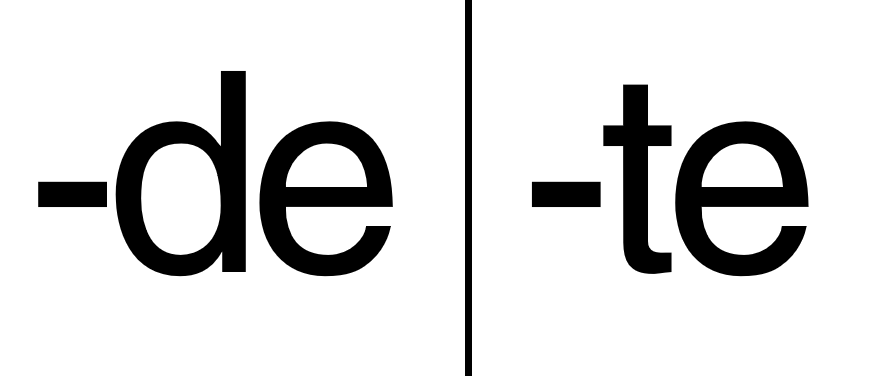Step By Step: How To Rule Dutch Weak Verbs! Posted by Sten on Mar 10, 2016 in Dutch Grammar, Dutch Language, Dutch Vocabulary
A zwak werkwoord (“weak verb” – a regular verb) is a verb that does not change in the past tense. For example leven, leefde, geleefd (to live, lived, lived). A sterk werkwoord (“strong verb” – an irregular verb) is one that does change, such as lopen, liep, gelopen (to walk, walked, walked). Then there are also “normal” onregelmatige werkwoorden (irregular verbs), like zijn, was, geweest (to be, was, been), and mixtures… But let’s start easy! First, I will discuss zwakke werkwoorden.
I’d like to believe that most verbs in Dutch are zwakke werkwoorden, because they are so easy to conjugate. However, I am absolutely not certain. In any case, here is a little guide how to create zwakke werkwoorden.
1. Find the stam (root)
How do you find the stam? Take off –en after the infinitive. In cases where the klank (sound) of the infinitive is long, it needs to stay long for the stam too. For those, you just add a vowel! In some cases, other letters need to be adjusted to readjust sound, but trust me: it sounds harder than it is.
The stam (root) of a verb is very useful. It helps you conjugate other verb forms, and at the same time is the imperative form of the verb and the form of the ik-persoon (I-person).
EXAMPLE
- Here an example where you need to add a vowel. Listen to the recording to hear the difference!
A. leven – to live
- leven – en = lev lev
- Add an e, switch v to f = leef <- the stam of leven!leef
- The e is added to make the e in lev longer.
- The v is exchanged by an f to make the v stemloos (voiceless), which a v at the end of a word would become. It therefore transforms into the soundless f.
- Here a normal example, without adding any stem (voice).
B. fietsen – to bike
- fietsen – en = fiets <- the stam of fietsen!fiets
Yes. That easy!
2. In the past tense, add -de / -te
2.1 The past simple
Now, the past tense does not get much harder. It is either a -de or -te that is added to the stam.
EXAMPLE
A. leven – to live
- leef + de = leefde (the singular form, in the plural, an n is added: leefden)
Hij leeft lang. (He lives long.)
Hij leefde lang. (He lived long.)
Wij leefden lang. (We lived long.)
B. fietsen – to bike
- fiets + te = fietste (also, in the plural an n is added: fietsten)
Ik fiets door het bos. (I bike through the forest.)
Ik fietste door het bos. (I biked through the forest.)
Wij fietsten door het bos. (We biked through the forest.)
2.2 The voltooid deelwoord (past participle)
This -de or -te is also added to the past participle. Normally, It also gets a ge- in front of the stam.
EXAMPLE
Hij heeft lang geleefd. (He lived/has lived long.)
Hij heeft door het bos gefietst. (He biked/has biked through the forest.)
But how do we know when to use the -de or -te? Well, there is a rule you can use!
3. ‘t Kofschip / Soft Ketchup
‘t Kofschip (the Koff ship), or often translated in English to “soft ketchup”, is an ezelsbruggetje (“donkey’s bridge” – a mnemonic) that helps you memorize when to use -de or -te. It only applies to the past tense and the participle – the present form is unaffected by it!
So how does it work?
All stammen that end on one of the medeklinkers (consonants) in ‘t kofschip, so t, k, f, s, ch and p, will have a -te. All other consonants end with a -de.
You might say: but what about geleefd? That is in ‘t kofschip but ends with a -de! Well, I think you know the answer… It has to do with replacing the v with the f. Cases where the last letter is changed and then becomes part of ‘t kofschip don’t count. And since the v is not in ‘t kofschip, it is leefde.
3.1 “Modernization” of the ship
A decade or-so ago, ‘t kofschip was modernized. Now, terms float around like ‘t kofschiptaxietje, or xtc-koffieshopje, or even something like “sexy ketchup” (although it doesn’t contain a j) to include medeklinkers that also require an -te ending. These are c, x, and j. Mostly, verbs that end in such a medeklinker are taken from other language, like the verb faxen (to fax). The stam is fax, and since it is in the kofschiptaxietje, it is faxte.
However, this “modernization” is contended. Since the ending -te or -de is related to the sound of the ending letter, the addition is unnecessary. The x and j end with an s-sound. The c has the k-sound. So they are already included in ‘t kofschip. But that seems a bit confusing, especially for language learners!
So remember ‘t kofschiptaxietje!
4. Practice!
Can you find the stam of the following verbs, and whether they go with -de or -te? Click on the play buttons to hear the words.
1. Roken (to smoke)
Stam – …
-de or -te? – …
2. Douchen (to shower)
Stam – …
-de or -te? – …
3. Zetten (to put)
Stam – …
-de or -te? – …
4. Lenen (to borrow)
Stam – …
-de or -te? – …
5. Roetsjen (to slide)
Stam – …
-de or -te? – …
6. Verhuizen (to move)
Stam – …
-de or -te? – …
7. Beëindigen (to end)
Stam – …
-de or -te? – …
8. Beloven (to promise)
Stam – …
-de or -te? – …
9. Maken (to make)
Stam – …
-de or -te? – …
10. Googelen (to google)
Contentious. “Googelen” is the official spelling, but “googlen” seems more logical and in line with the actual name of the search giant!
Stam – …
-de or -te? – …
Find the answers on our Facebook page!

Build vocabulary, practice pronunciation, and more with Transparent Language Online. Available anytime, anywhere, on any device.
About the Author: Sten
Hi! I am Sten, both Dutch and German. For many years, I've written for the German and the Dutch blogs with a passion for everything related to language and culture. It's fascinating to reflect on my own culture, and in the process allow our readers to learn more about it! Besides blogging, I am a German-Dutch-English translator, animator and filmmaker.







